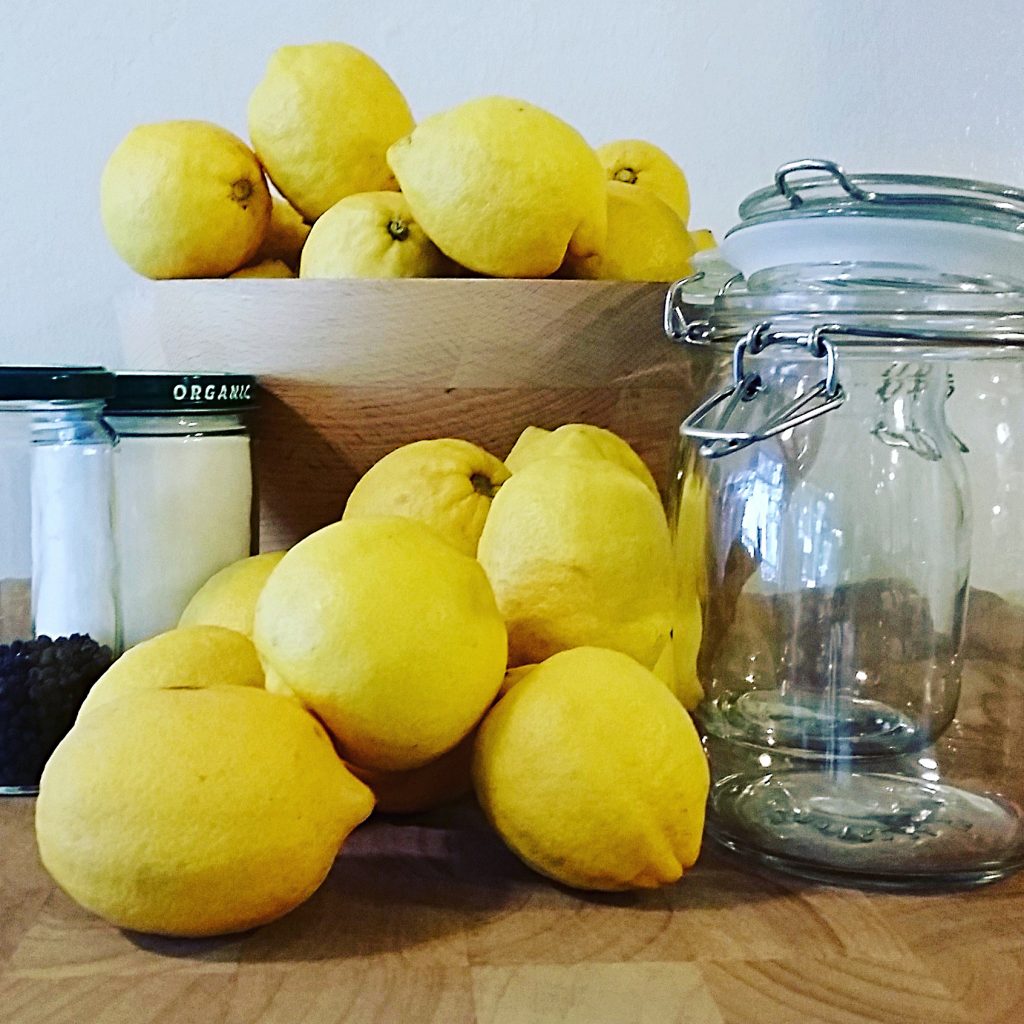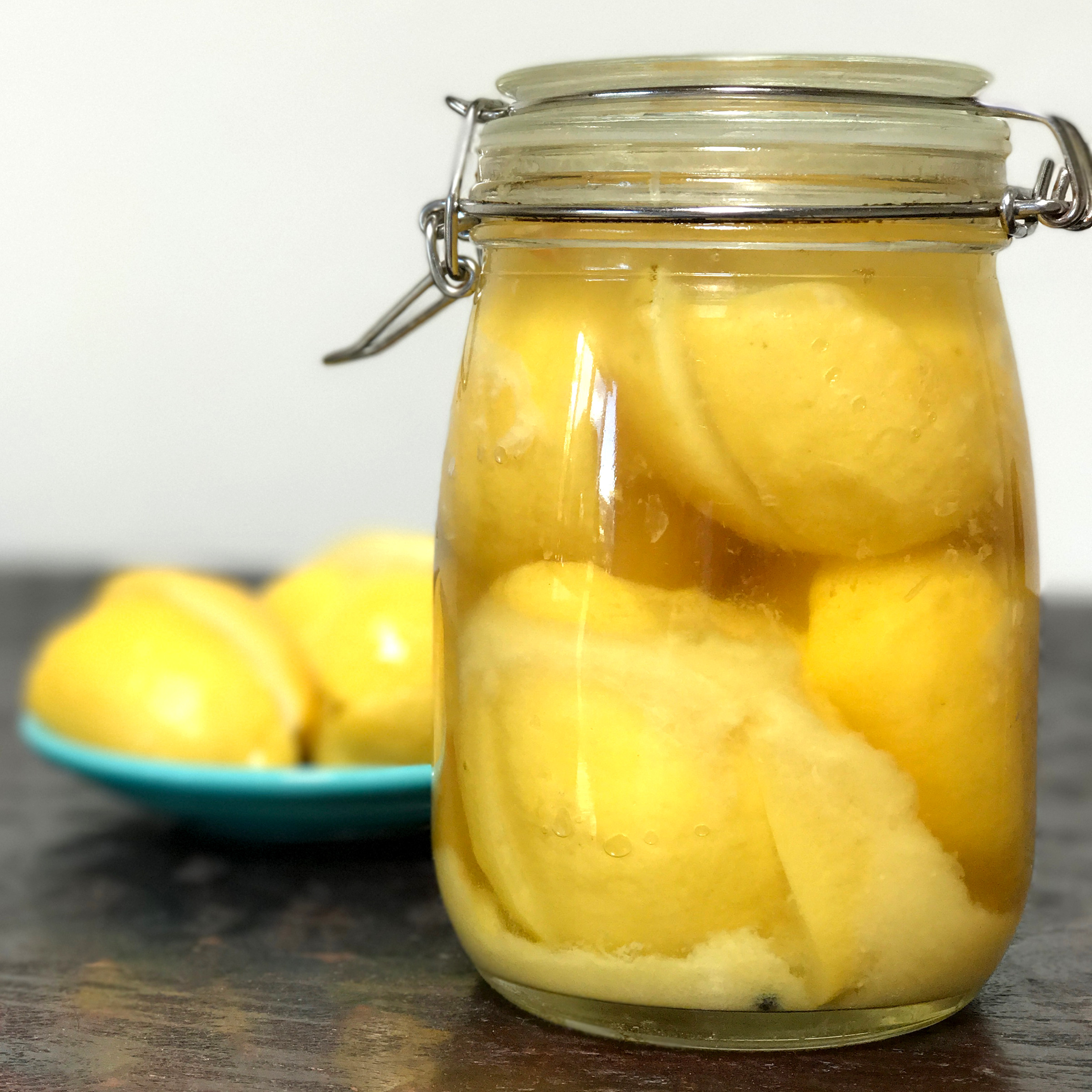Updated 01/23/18
If you prefer your food bland, skip this blog post.
Until now, when I made preserved lemons in the past, honestly, I struggled to use up an entire jar. Classically, you use preserved lemons in chicken tagine but we don’t eat much chicken. They go well with fish but we eat little fish. You can use them in dressing, but we can eat only so much salad. On top of that, my picky eater won’t touch anything fermented (although she finally tried my ginger beer and liked it—mothers of picky eaters, take heart). With their intensely pungent, walloping umami, super salty and complex flavor, you typically add only a small amount to a dish. How could I possibly use up entire jars of these flavor bombs? I stopped making them. Me, with the prolific lemon tree. What a shame.
Then at my favorite Indian restaurant one night a couple of months ago, my boyfriend Chandra commented on the delicious lemon in the side of pickle we order with our vegetarian tali every time we eat at Darbar. The pickle I eat about once a month or so. The pickle that I adore.
:O
I picked up the pickle. Preserved lemon. Right there. In the small white dish. How could I not have noticed?
Within a couple of days, I had two large jars of preserved lemons going on my counter.
If you can find preserved lemons in a grocery store, they will cost you a small fortune—around 10 dollars for an 8-ounce jar, more for organic. Although they are worth the price, if you have a jar, some salt, a bunch of lemons and patience—these sit for a month or longer—you can easily make them yourself. Because I have a lemon tree, mine cost me basically nothing. I used about 10 lemons for each 1-liter jar pictured below—six to preserve and four for additional juice that goes into the jar.
You can also preserve limes but will need more per jar. Follow the same basic instructions below.
Non-organic lemons, food-grade wax
I use organic lemons from my yard for these. You can find organic lemons at many grocery stores but they may be coated in food-grade wax. If, like me, you would prefer not to eat peels coated in wax, ask your grocer if the lemons have been coated. I have read online that you can pour boiling water over waxed lemons and then scrub off the wax but boiling water will kill the beneficial microbes that you need to ferment these.
Basic preserved lemon directions
Now that you have your lemons, here’s all you do: cut each lemon into quarters but don’t cut all the way through. Leave about 1/2 inch at the bottom to keep the lemons attached. Stuff about 1 tablespoon of salt into the lemon. Stuff the lemon into a clean jar. Stuffing in the lemons will release some juice but you’ll need to add more. Once you have filled the jar with lemons, pour additional lemon juice over them until you have completely covered the lemons in juice. Submersion is very important! These will turn mushy or worse—moldy—if you don’t submerge them completely in liquid. If you do encounter white mold on the surface of the liquid as these ferment, just scrape it off. The lemons will be fine. (I have lived to tell the tale.)
Recipes for preserved lemons vary. Some call for lemons and salt only. Others call for spices such as bay leaves, cloves, coriander seeds, peppercorns, and cinnamon sticks. For this post, I added some peppercorns—five or six—to each jar before I shoved in the lemons.
Submerge the prepped preserved lemons
After I filled the jar, I then put a tiny jam jar (without its lid) on top of the lemons and closed the jar. The lid of the big jar pushes down the little jar, which shoves down the lemons, and causes the liquid to rise and submerge everything. Set the jar aside on a plate to catch any oozing lemon juice. Burp the jar (i.e., open it) every day for the first several days to release any gases building up in there. Wait a month or longer.
How to cook with preserved lemons
Use your lemons when the skins have softened completely. Scrape away the pulp, rinse off the salt (depending on the recipe) and add the rinds to your dish.
But what about the pulp? Most recipes that call for preserved lemon instruct you to toss it. That won’t do on this blog. I have some ideas for using the delicious pulp:
- Add it to salsa. Delicious. Chandra makes salsa often so I threw some pulp in there as a test. Yum.
- Throw it into soup or sauce. If you want to add a complex lemon flavor to a soup or sauce, toss the pulp in in. Simply break it up with a wooden spoon.
- Add it to salad dressing. Push it through a strainer first or whir the pulp in a food processor and use it all in salad dressing.
- Add it to hummus. My hummus recipe calls for lemon and salt like most hummus recipes. How delicious would it taste with preserved lemon pulp, I wondered. Very delicious it turns out! (Here’s the recipe.) We couldn’t stop eating it.
In short, add the pulp to dips, soups, sauces and dressings that need a bit of oomph. Go here for more ideas.
Now I worry about running out of preserved lemons. Chandra and I have been chopping up the preserved lemon peels, mixing them with fermented hot peppers and eating that with my chana masala. So good! All this time, I’ve had the makings of a delicious side pickle and didn’t even realize it! Maybe we’ll just eat in every night.
Preserved Lemons
Ingredients
- 10 lemons
- 6 tablespoons sea salt
- if desired: bay leaf, cloves, coriander seeds, peppercorns or cinnamon sticks
Instructions
- Cut lemons into quarters but don't cut all the way through. Leave about half an inch at the bottom intact to keep the lemon pieces attached.
- Stuff about 1 tablespoon of salt into a cut lemon and stuff the lemon into a clean 1-liter jar. If desired, cut the rinds of one or two juiced lemons and add them to the jar.
- Once you have filled the jar with lemons, juice the additional lemons and pour juice into the jar until you have completely covered the lemons.
- Close the jar and set it on a plate to catch any lemon juice that may soon begin gurgle out of the jar when fermentation begins. Burp the jar (i.e., open it) every day for first several days to release any gases building up inside. Set the jar aside for from a month to up to six months.
- The lemons are ready when the skins have softened completely. Scrape away the pulp, rinse off the salt (if necessary) and add the rinds to your dish.


